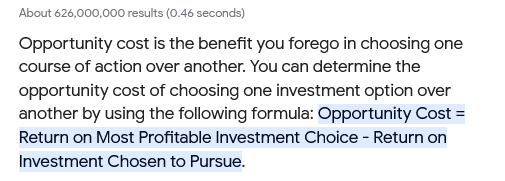Understanding Opportunity Cost: A Comprehensive Guide
Introduction to Opportunity Cost
In finance and economics, opportunity cost is a pivotal concept central to decision-making and resource allocation. Opportunity cost represents the potential benefits an investor, individual, or business misses out on when choosing one alternative over another. Grasping this concept is crucial for effective management of resources and strategic planning.
What is Opportunity Cost?
Opportunity cost is the value of the next best alternative that is foregone due to making a decision. It’s a theoretical concept and a practical tool used across various fields like finance, economics, and daily life decisions. It helps assess the potential benefits one misses when choosing a particular action over another.
Calculating Opportunity Cost in Economics
In economics, opportunity cost plays a vital role in resource allocation. It helps in understanding the trade-offs when resources are limited. The calculation is straightforward: subtract the return of the chosen option from the return of the best-foregone alternative.
Formula:
Opportunity Cost = Return of Best Foregone Option – Return of Chosen Option
Opportunity Cost in Investment Decisions
Investors frequently use opportunity costs to compare investments. It helps in evaluating the potential returns from different investment options, guiding them to allocate resources more effectively.
Example:
If an investor chooses investment A, which returns 5%, over investment B, which returns 7%, the opportunity cost is 2% (7% – 5%).
Opportunity Cost in Business Decisions
Businesses often face decisions involving opportunity costs, such as production choices, resource allocation, and capital investments. Understanding and calculating opportunity costs aids in making decisions that maximize potential returns.
Example:
A business choosing between two projects must consider the potential profits from each, determining the opportunity cost as the profit foregone by not choosing the alternative.
Opportunity Cost in Daily Life
Everyday decisions, from choosing to work overtime to spending on leisure, involve opportunity costs. Understanding this concept can help to make more effective and informed personal choices.
Personal Decision Example:
Spending time watching a movie over working on a side project involves the opportunity cost of the income or experience that could have been gained from the project.
Common Misconceptions About Opportunity Cost
It’s Not Always About Money:
Opportunity cost isn’t limited to financial decisions. It encompasses time, convenience, and other non-monetary factors.
Sunk Costs are Irrelevant:
In calculating opportunity cost, sunk costs (costs that have already been incurred and cannot be recovered) should not be considered, as they do not affect future decision-making.
Importance of Opportunity Cost in Strategic Decision-Making
Understanding the idea of lost opportunities is essential for making informed decisions that maximize the potential value of resources. It provides a framework for evaluating the cost and benefit of various alternatives, leading to more effective resource allocation.
Key Takeaways for Decision Makers:
- Evaluate all possible alternatives.
- Consider both monetary and non-monetary factors.
- Focus on future benefits and costs, not sunk costs.
Conclusion: Mastering the Art of Calculating Opportunity Cost
Mastering the calculation and understanding of opportunity cost is crucial for individuals, investors, and businesses alike. It aids in making informed decisions, allocating resources efficiently, and maximizing potential benefits. By considering the value of foregone alternatives, one can navigate the complex world of economics and finance with greater insight and effectiveness.
